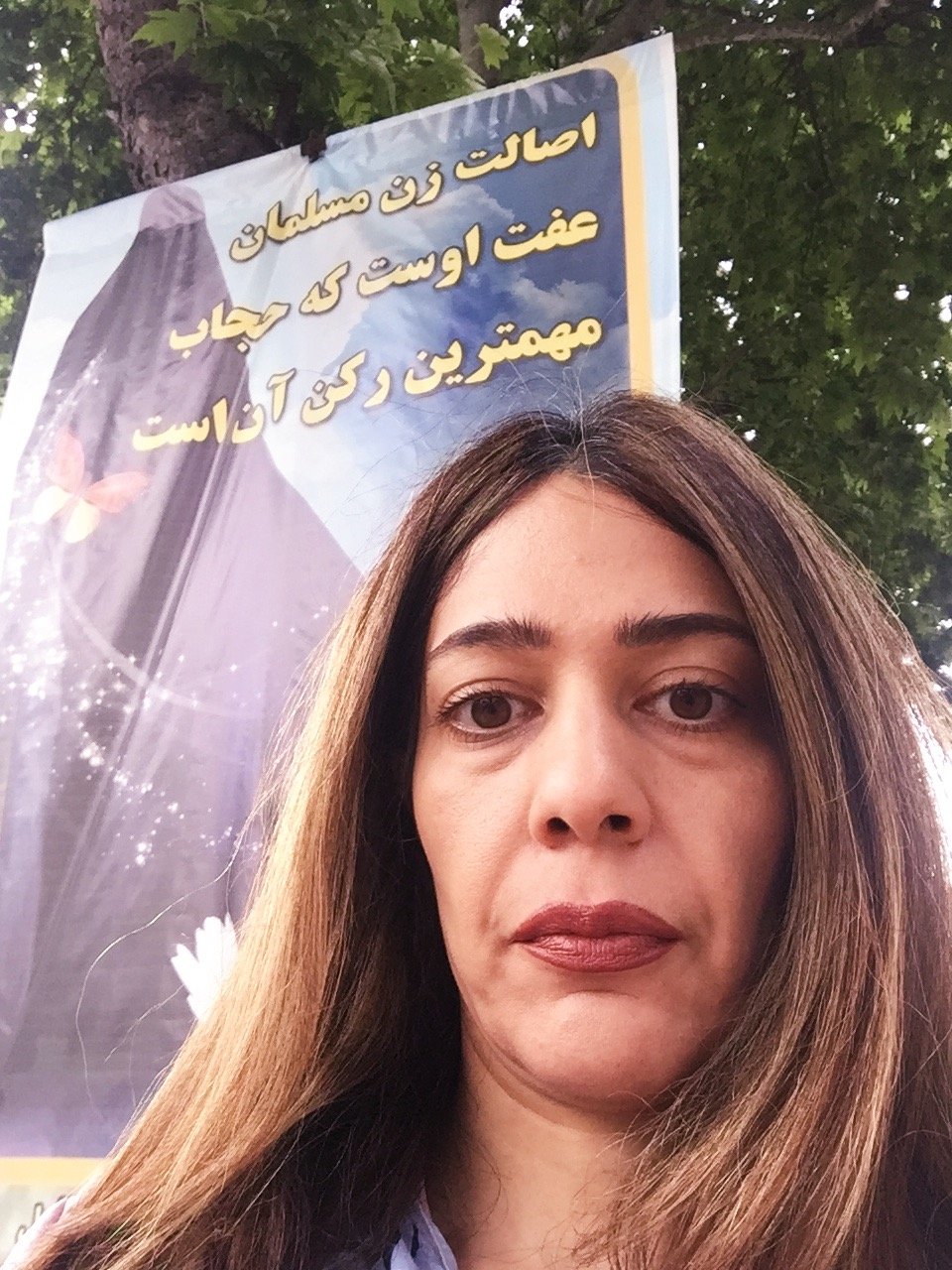Reclaiming Power: How 'Saliteh' Became a Symbol of Resistance Among Iranian Women
“With whose permission are you filming me?” the young woman asked.
She was caught off guard. Crouched on the clinic floor, she had been breastfeeding her sick infant and probably didn’t recall the moment her headscarf slipped off.
Looking up, the young woman became aware of a cleric filming her with his cell phone nearby. It could mean only one thing: he would be reporting her to the authorities for violating Iran’s mandatory hijab law.
The young woman stood up to confront the cleric, demanding he delete the footage. He refused and ordered her to cover her hair. Bystanders intervened, but the cleric continued filming. The distressed woman fainted and was taken to another room by clinic personnel.
A screenshot from the Qom hospital video published on March 9, 2024, shows a mother holding her sick infant, hair uncovered, as a mullah films her on his phone nearby.
The encounter in March went viral, prompting widespread outrage on Persian-language social media and users condemning the cleric’s actions. Supporters of the clerical regime countered by calling the young mother a “saliteh” (loosely translating to “slut”) online, triggering Iranian women to respond in solidarity with the hashtag #WeAreSalitehs.
ما_سلیطهایم# became a trend.
The incident occurred amidst ongoing defiance of the compulsory hijab law. Almost a year and a half after the death of Mahsa Amini at the hands of the morality police for alleged “improper hijab,” women across the country are appearing in public without head coverings in acts of civil disobedience. Authorities have intensified crackdowns upon women ever since, with enforcers often committing acts of harassment and assault.
In other words, giving themselves permission to a) invade women’s privacy and b) violate their freedom over their bodies, namely, what to wear.
I am reminded of my own experience on a 2018 visit to Iran. I was walking back home from the market on a summer day. It was sweltering, so I let the tails of my headscarf fall loose instead of wrapping it around my neck, revealing a bit more skin and hair than normal. My arms were also bare below the elbows. Suddenly, an older man exited his car and approached me, blocking my path.
“What do you think you’re doing, dressing like this?”
Seeing the menace in his eyes, I was hesitant to answer him. Hoping he would leave me alone, I continued walking. When he reappeared in front of me, I explained that the weather necessitated it, but even if that wasn’t the case, it didn’t warrant his interference. He then threatened to report me to the authorities. I told him to be my guest and left.
During my recent stay in Iran last year, observing the masses of women openly defying hijab rules gave me hope. Yet authorities would resort to tactics such as propping up billboards in public spaces with slogans extolling the virtues of chastity or promoting veiling as a religious mandate. Guards were out and about monitoring women’s dress codes. On one occasion, as I was walking around town, a female officer yelled at me for “dressing immodestly,” all because I had on a skirt that reached above my ankles. The next day, I stood in front of one of the propaganda billboards with my hair uncovered, took a selfie, and posted it as a story on my Instagram page in a small act of vengeance.
Tara’s Instagram story.
If that were to happen now, I’d post it with the hashtag #IAmASaliteh.
Negative connotations aside, the core definition of a Saliteh is a woman who speaks her mind, does not conform to societal expectations, and reclaims her power. She is someone who cannot be silenced or controlled.
In the words of women’s rights activist Samaneh Savadi: “A Saliteh is a woman with the voice of resistance. Either we accept that she should continue to be marginalized, or overcome the stigmas surrounding the word and dare to label ourselves as such.”
Part of the problem is that characteristics such as assertiveness and outspokenness are culturally associated with men. Recent events reveal how the narrative is slowly changing, but it is safe to say that, for the most part, a Middle Eastern woman has been expected to stick to her gender roles.
My mother is a prime example of this. Quite the public figure in her hometown and province, she is active in community organizing, real estate ventures, interpretation, education, and immigration advising, all while being outspoken and authoritative. For as long as I can remember, townspeople would define her as “like a man” (meaning just as good as, or no less than, men).
I wouldn't say I liked the comparison. Especially since, in our culture, we have an expression for women revered for their strength: shirzan, whose literal translation is “lioness.” The origins of the term go back to the Shahnameh, or epic of kings, where female heroines assumed the role of warriors and were celebrated for their grace and fearlessness. Historical records show that women in Iran enjoyed a level of status and rights unparalleled in the ancient world.
Amid all the struggles, it is heartening to realize that all it takes is looking within ourselves and uncovering our roots to embrace the freedom and empowerment we strive for. Witnessing this generation of women in Iran demanding their rightful place as equals renews hope.
Whether redefining the saliteh or rectifying patriarchal mindsets, the mandate to reclaim the overarching narrative is clear. Perhaps Forugh Farrokhzad, our famed poetess, said it best in the poem: To My Sister.
Rise up and uproot the roots of oppression
give comfort to your bleeding heart.
For the sake of your freedom, strive
to change the law, rise up.



